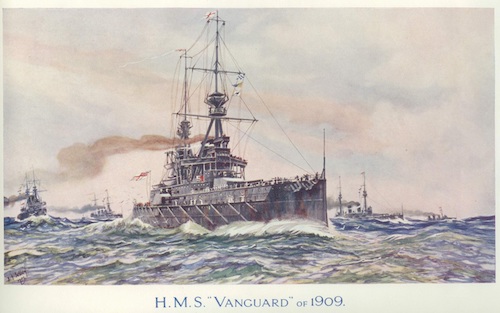Remembering HMS Vanguard at the Orkney Museum

As part of this month’s HMS Vanguard commemorations, the Orkney Museum is displaying items which tell the story of the life and tragic sinking of the vessel, 100 years ago.
A century-old promotional brochure is on loan from the Dock Museum in Barrow- in- Furness. The brochure was produced when the vessel was launched on February 22, 1909.
Rachel Boak, Curator at the Orkney Museum, said the museum wanted to provide a continuing focus for the tragedy, while also telling a bit of the story about the vessel itself.
She said: “We’re delighted to have the original brochure on loan from the Dock Museum — it’s interesting to see what promotional material for a new ship was like 100 years ago. Familiar objects and images from the past really drive home how very real this ship – and its disastrous fate – was.
“As well as the brochure, we have a photograph of the vessel being launched, and of the ship’s bell, also at the Dock Museum, and photos from the Orkney Library and Archive collection, including a picture of the two survivors of the tragedy.
“We have included quotes from an eyewitness account of the explosion by Leading Mechanic E. H. March, who was stationed at Houton Seaplane Station and saw – and felt – the explosion that devastated the ship. He speaks of first seeing a column of fire and debris, followed by a shockwave ten seconds later which ‘was heavy enough to momentarily stop my breath.’ It is a sobering read.
Royal Navy battleship HMS Vanguard was blown apart at Scapa Flow in Orkney on Sunday, July 9, 2017, with a series of internal explosions destroying the ship, sinking it almost immediately. Only two of the 845 men on board survived.
The catastrophic loss of the dreadnought battleship, which had seen action at the Battle of Jutland, is counted as one of the most tragic accidents in the history of the Royal Navy.
Although the exact cause of the incident has not been proven, the accepted explanation is that a fire started in a fuel compartment adjacent to one of Vanguard’s armaments magazines – the intense heat then igniting cordite in the magazine, triggering the explosions that blew the ship apart.
Sabine Skae, Collections and Exhibitions Manager at the Dock Museum, said: “Through the Vanguard, Barrow and Orkney have a special link. HMS Vanguard was built by Vickers Sons and Maxim in Barrow-in-Furness, where the Dock Museum is based.
“We’re delighted to be able to loan the ship’s launch brochure which we hope helps bring to life the story of the Vanguard. We also wanted to help commemorate this important anniversary.”
A range objects from HMS Vanguard are also on permanent display at the Scapa Flow Visitor Centre and Museum, in Lyness, including a vase and whistle belonging to the donor’s father, Howard Davis, who was attending a concert party on HMS Royal Oak when the Vanguard blew up at anchor.
Some of the crew were buried at the Royal Naval Cemetery at Lyness where there is a memorial to the men who died. You can watch a short video on the museum.
The Dock Museum tells the rich story of Barrow-in-Furness, including its vibrant shipbuilding industry in the nineteenth and twentieth centuries. It was Barrow’s shipyard that built the Royal Navy’s first submarine in 1901. The Museum itself is built into a Victorian dry dock. Find out more at the Dock Museum’s website.

